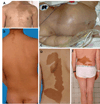McCune-Albright syndrome and the extraskeletal manifestations of fibrous dysplasia
- PMID: 22640971
- PMCID: PMC3359955
- DOI: 10.1186/1750-1172-7-S1-S4
McCune-Albright syndrome and the extraskeletal manifestations of fibrous dysplasia
Abstract
Fibrous dysplasia (FD) is sometimes accompanied by extraskeletal manifestations that can include any combination of café-au-lait macules, hyperfunctioning endocrinopathies, such as gonadotropin-independent precocious puberty, hyperthyroidism, growth hormone excess, FGF23-mediated renal phosphate wasting, and/or Cushing syndrome, as well as other less common features. The combination of any of these findings, with or without FD, is known as McCune-Albright syndrome (MAS). The broad spectrum of involved tissues and the unpredictable combination of findings owe to the fact that molecular defect is due to dominant activating mutations in the widely expressed signaling protein, Gsα, and the fact these mutations arises sporadically, often times early in development, prior to gastrulation, and can distribute across many or few tissues.The complexity can be mastered by a systematic screening of potentially involved tissues and cognizance that the pattern of involved tissues is established, to some degree, in utero. Thorough testing allows the clinician to establish, often times at presentation, the full extent of the disease, and importantly as well what tissues are unaffected. Treatment and follow-up can then be focused on affected systems and a meaningful prognosis can be offered to the patient and family. The authors outline screening and treatment strategies that allow for effective management of the extraskeletal manifestations of FD.
Figures




Similar articles
-
Extent of Extraskeletal Manifestations of Fibrous Dysplasia/McCune-Albright Syndrome in Patients with Mazabraud's Syndrome.Calcif Tissue Int. 2022 Mar;110(3):334-340. doi: 10.1007/s00223-021-00918-0. Epub 2021 Dec 2. Calcif Tissue Int. 2022. PMID: 34854944
-
McCune-Albright syndrome.Orphanet J Rare Dis. 2008 May 19;3:12. doi: 10.1186/1750-1172-3-12. Orphanet J Rare Dis. 2008. PMID: 18489744 Free PMC article.
-
McCune-Albright syndrome: clinical picture and natural history in children and adolescents.J Pediatr Endocrinol Metab. 2006 May;19 Suppl 2:551-9. doi: 10.1515/jpem.2006.19.s2.551. J Pediatr Endocrinol Metab. 2006. PMID: 16789617 Review.
-
Fibrous Dysplasia/McCune-Albright Syndrome: Clinical and Translational Perspectives.Curr Osteoporos Rep. 2016 Oct;14(5):178-86. doi: 10.1007/s11914-016-0317-0. Curr Osteoporos Rep. 2016. PMID: 27492469 Free PMC article. Review.
-
[McCune-Albright syndrome revealed by Blaschko-linear café-au-lait spots on the back].Ann Dermatol Venereol. 2016 Jan;143(1):21-6. doi: 10.1016/j.annder.2015.10.585. Epub 2015 Nov 25. Ann Dermatol Venereol. 2016. PMID: 26610360 French.
Cited by
-
Craniofacial Fibrous Dysplasia: Clinical and Therapeutic Implications.Curr Osteoporos Rep. 2023 Apr;21(2):147-153. doi: 10.1007/s11914-023-00779-6. Epub 2023 Feb 28. Curr Osteoporos Rep. 2023. PMID: 36849642 Free PMC article. Review.
-
Carney complex and McCune Albright syndrome: an overview of clinical manifestations and human molecular genetics.Mol Cell Endocrinol. 2014 Apr 5;386(1-2):85-91. doi: 10.1016/j.mce.2013.08.022. Epub 2013 Sep 5. Mol Cell Endocrinol. 2014. PMID: 24012779 Free PMC article. Review.
-
The utility of liquid biopsy in clinical genetic diagnosis of cancer and monogenic mosaic disorders.Med Genet. 2023 Dec 5;35(4):275-284. doi: 10.1515/medgen-2023-2066. eCollection 2023 Dec. Med Genet. 2023. PMID: 38835734 Free PMC article.
-
[Fibrous dysplasia].Orthopade. 2012 Dec;41(12):993-1006. doi: 10.1007/s00132-012-1996-6. Orthopade. 2012. PMID: 23179266 German.
-
[Fibrous dysplasia].Orthopadie (Heidelb). 2024 Oct;53(10):805-816. doi: 10.1007/s00132-024-04548-w. Epub 2024 Sep 5. Orthopadie (Heidelb). 2024. PMID: 39235640 German.
References
-
- McCune DJ. Osteitis fibrosa cystica; the case of a nine year old girl who also exhibits precocious puberty, multiple pigmentation of the skin and hyperthyroidism. Am J Dis Child. 1936;52:743–744.
-
- Albright F, Butler AM, Hampton AO, Smith PH. Syndrome characterized by osteitis fibrosa disseminata, areas of pigmentation and endocrine dysfunction, with precocious puberty in females, report of five cases. N Engl J Med. 1937;216:727–746. doi: 10.1056/NEJM193704292161701. - DOI
-
- Cremonini N, Graziano E, Chiarini V, Sforza A, Zampa GA. Atypical McCune-Albright syndrome associated with growth hormone-prolactin pituitary adenoma: natural history, long-term follow-up, and SMS 201-995--Bromocriptine combined treatment results. J Clin Endocrinol Metab. 1992;75:1166–1169. doi: 10.1210/jc.75.4.1166. - DOI - PubMed
-
- Benjamin DR, McRoberts JW. Polyostotic fibrous dysplasia associated with Cushing syndrome. Arch Pathol. 1973;96:175–178. - PubMed
Publication types
MeSH terms
Substances
Supplementary concepts
Grants and funding
LinkOut - more resources
Full Text Sources
Medical

